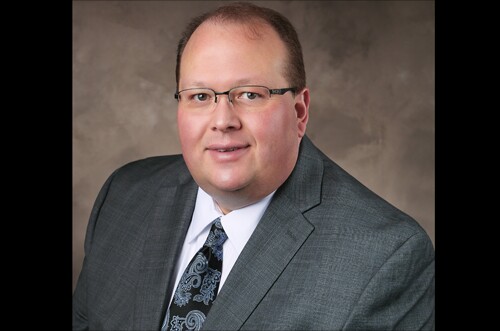

CBW Bank Readies Launch of Real-Time Payments
CBW Bank aims for nothing less than to reinvent the bank account.
The innovative Weir, Kansas bank (it was the original institution behind BankSimple and Moven, and partners with cryptocurrency firm Ripple Labs on cross-border payments) will formally launch a new payment tool called the ONE Card this quarter.
It offers something most banks can't, and which the Federal Reserve has begun nudging the industry to build: real-time payments.
To create this capability, $12 million-asset CBW has signed agreements with all the major U.S. debit networks for the ability to use their rails to instantly credit bank accounts.
If a customer wants immediate access to the funds from a check, a wire transfer or some other payment, she can get it.
"The way existing bank accounts are structured is not going to meet the needs of future consumers and what they want to do with their money," said Suresh Ramamurthi, chairman, CBW Bank. "There are times when, at 2:00 a.m., you need to pay someone."
CBW is currently offering the real-time payments through business clients. (The technology behind the project was built by Yantra Technologies, which Ramamurthi also runs.)
"We have a check casher using this to, strangely enough, put money back into a bank account after they cash your check," Ramamurthi said. "It makes no sense, right? But they have very high volume because lots of people don't want to deposit a check in their bank Friday evening, because they won't have the funds available until Monday or Tuesday. They go to a check casher and have the money put into the bank account in a minute."
An insurance company is using the ONE card to pay claims to people who need the money right away. (It may discount the amount it pays in exchange for the fast service.)
The ONE card account is also being used by a health insurance company to provide information about payments along with the payments themselves, to help explain what it's actually paying for (which often doesn't match what the patient was billed).
Setting up the agreements with the debit networks was a challenge of data and diplomacy. The networks each use a slightly different data format that the bank needed to accommodate.
The diplomacy came in the bank's relentless pursuit of the debit networks to get them to sign on. Some were more interested in this new use case for their payment technology than others.
"Nobody came to us and said, Please do this because we really want to innovate,'" he said.
In the future, the bank plans to add analytics for risk management and market segmentation to the ONE account, as well as the ability to give online banking customers access to their entire transaction history.
"Did I ever eat at Olive Garden? You'll be able to find that," Ramamurthi said.

Naugatuck Valley Gets Big Picture in Risk Management
Naugatuck Valley Savings and Loan decided it was time to overhaul its enterprise risk management after seeing inefficiencies, regulatory oversight and wasted man hours mount.
A team of more than 50 employees at the $491 million-asset company spent last year implementing the WolfPAC enterprise-wide risk management program. The software allows the Connecticut lender to quickly assess technologies and critical vendors for their compliance with more than 40 regulations. Its management team can now easily check to make sure risk assessments are up to date.
Previously, the bank used spreadsheets on a shared drive to outline and rate risk management practices, a process that was time-consuming and inefficient, said James Cotter, the company's chief operating officer. The spreadsheets were not integrated with each other, so often work had to be repeated.
So far, Naugatuck has saved roughly 100 to 150 man hours with the upgrade, Cotter estimates.
"We recognized that regulators were more focused on risk management and we realized that we had inefficiencies in this area," Cotter said. "We were able to kill two birds with one stone."
It was challenging to get everyone to commit the time required to complete the project but it had the support of senior management so "the message was delivered strongly that we needed to get this done," Cotter said. Naugatuck was able to complete the entire integration in a year and implement more than 700 risk assessments.
But all of the effort and resources dedicated to the project were worth it in the end, said Rita Myers, a senior operations officer at Naugatuck.
"When we actually saw this beautiful final report and how all of these risk assessments tied into each other, it was a nice moment," she added. "Everyone took a deep breath."

Bank of North Carolina's iPad App Helps Frontline Staff Sell
Community banks have traditionally struggled to sell additional products to customers. But Bank of North Carolina hopes it has found a solution to this common conundrum.
The $3.7 billion-asset bank, a unit of BNC Bancorp in High Point, is piloting mobileBANKER, an iPad and desktop application it co-developed with Zenmonics that supports sales and customer relationship management. The bank has been on an acquisition spree in recent years it has purchased 10 banks since 2010. As the company's branch network grew, management realized that it could no longer rely on Excel as a customer sales platform.
Now the company is piloting, at two branches and among its private bankers, an application that can quickly identify products and services to discuss with customers. If a customer isn't interested in a product, the system won't suggest offering it again for 18 months. The iPad application allows the company's bankers to call on customers outside of the office while still having access to key information.
"It has the smarts to know what products you have and what you don't have, so with just a glance you can bring up a customer and begin a conversation" about new services, said Michael Bryan, the company's chief information officer. "It gives our sales force the confidence to begin talking about products."
Bank of North Carolina has been working on the project for about 14 months and established an internal committee, including representatives from consumer banking, marketing, compliance and IT, to help with the project. The company plans to expand the use of the application to commercial bankers, ATMs and other areas.
"When you are a small bank you tend to know your customers better," Bryan said. "As the products evolve, it is hard to know what every customer has and as we got larger we needed a tool that could tell us what we needed to talk about with customers."

Wintrust Financial Connects Mobile App with ATMs
Wintrust Financial is the first bank in the U.S. to commercialize a technology that pairs the ATM with the smartphone so its customers can preorder cash withdrawals through a mobile app instead of inserting a physical card.
The journey to launching the novel feature began when the Rosemont, Ill., company was chatting with FIS about how to become more creative to compete with the giants like JPMorgan Chase and Bank of America.
Together, they settled on a mobile wallet strategy that began with getting consumers to use the ATM-linked mobile app, then selling merchants on the product down the road.
"We decided nobody will use the mobile wallet without showing that customers are willing to use the mobile wallet," said Thomas Ormseth, senior vice president of noncredit services at Wintrust Financial.
In February, the holding company broadened its months-old pilot out to dozens of ATMs as it works to collect the usage data. The transaction requires a person to use his phone to scan a barcode to get the cash at the ATM, and in turn, get a glimpse of what a mobile wallet is like.
Ormseth said some individuals have harbored initial reactions of "so what?" until they use the feature. One of Wintrust's "aha" moments occurred when a 64-year-old seemed ho-hum about the update. But after trying it out as a favor to the bank, the senior said: "This was [expletive] cool."
The reaction made Ormseth feel the bank was onto something. And it's not an isolated case. "We are getting good feedback and the age hasn't mattered, which surprised us," he said.
And if the bank markets the feature properly, Ormseth said it will help brand the bank as a company that provides the best of both worlds: Branches and the ability to do tech-related things even the biggest rivals have yet to offer.
The longer term goal is to monetize the investment through a robust mobile wallet in addition to acquiring and retaining customers along the way by providing well-thought out mobile features.

Radius Bank Overhauls Its Digital Banking Platforms
Radius Bank, with only one full-service branch, identifies the digital channel as the way to grow.
"We are not believers in building the branch out," said Robert Landstein, executive vice president and chief information officer at the Boston bank.
So in 2014, the $725 million-asset bank overhauled its public website in addition to revamping its online and mobile banking platform in a bid to make them easier to use. In the updates, Radius launched a website feature few others have yet: it lets consumers use their smartphones' cameras to scan their driver's licenses and input data into the mobile application. In so doing, the applicants are saved some of the trouble of manual data entry required of the form.
"It gets tedious on the little keyboard on the phone," said Landstein. The update, which is available through its mobile website and powered by Bottomline Technology's Andera, is meant to make the process less troublesome.
Interestingly, Radius also chose to use a mash-up of vendors for its public and authenticated website to get what it wanted. "We really wanted the best of breed," said Landstein.
Jack Henry is hosting the public website (with much of design work created internally), while the authenticated website is hosted by Q2. The latter required more work of the bank as it said it is one of the first institutions to roll out the vendor's latest online and mobile banking product.
"We had to do more testing," said Landstein. "It was quite an adventure." One week, the branding colors would be entirely different, while the next week's build could uncover complications in bill pay, for example.
The time invested was well worth it, as Landstein believes the digital overhaul will help land new customers and improve loyalty, and eventually save money.
"It's less expensive than building a branch on one more corner but the reach is much bigger," said Landstein.

Orrstown Bank Steps Up Its Cyber Threat Analysis
With the threat of cyberattacks mounting and following JPMorgan Chase's breach in 2014 Orrstown Bank wanted to find a way to more quickly detect anomalous behavior in its performance, application and network data logs.
"If attackers can penetrate environments like JPM, we have to work under the assumption they can penetrate us as well," said Andrew Linn, senior vice president and chief information security officer at the Shippensburg, Pa., bank.
So Orrstown decided to subscribe to Splunk Cloud to better monitor, analyze and visualize its data in one place, at a time when the institution's log events continue to grow.
Orrstown, which has $1.2 billion in assets, employs several former IT execs from JPMorgan Chase who had been exposed to the Splunk technology there.
The tool is designed to crunch enterprise data in a single place to monitor for specific behaviors and spotlight potential trouble within the enterprise quickly.
"You can collect all the log data you want," said Linn. "But if you are not sure what the bad behavior is, you can find yourself drowned in data."
Orrstown, which has linked 60 of its data sources to Splunk, knows that it normally sees very low traffic in and out of the bank's data center at night, for example. So if Splunk alerts the bank to a large amount of traffic flowing from its data center to the public Internet off-hours, it's an indicator that something requires investigation.
Luckily, no breaches have been caught. Rather, tangible benefits from using Splunk include having a way to show auditors answers to questions the institution may not have anticipated. Orrstown has also found Splunk's intuitive user interface benefits its help desk in answering employee questions more quickly.
"Very simple searches are possible," said Chris Thompson, Orrstown's senior vice president and chief architect, who led the Splunk project.
Orrstown is also conducting an ATM upgrade with Diebold and plans to use Splunk on the devices in order to more quickly detect when one is down.

C1 Financial Boosts SBA Lending with Mobile App
When C1 Financial decides it needs a new technology application, it doesn't turn to an outside software developer or an off-the-shelf solution. Why should it? The $1.5 billion-asset St. Petersburg, Fla.-based community bank has an in-house team of highly skilled developers that has already produced a number of applications for C1 bankers and customers.
President and chief executive Trevor Burgess sees his technology development team, C1 Labs, as a differentiator for his four-year-old company, producing products it can use to generate business and, eventually, sell to other banks. C1 raised more than $42 million in an initial public offering last year. In its registration document, the company revealed it was "exploring the opportunity of licensing these technologies to third parties."
C1 has not announced any deals to date, but in a conference call last month, Burgess hinted some news might be forthcoming. "We hope to provide a full update on C1 Labs and our technology developments in the next few months," he said.
The unit has produced a number of apps C1 is using internally.
One of the newest, SBA 1st, is an application for iPhone or Android that educates potential borrowers on Small Business Administration loan products and provides a quick determination of their eligibility. Burgess said C1 is still testing SBA 1st, but he added the product has fared well and he is hopeful it can help boost the company's SBA lending. Indeed, with the new app in mind, Burgess said C1, which booked $489 million of loans in 2014, wants to boost its SBA lending to 10% of total origination volume.

Eastern Bank Invests $4M Annually in Tech Lab
Who says you can't teach an old bank new tricks?
Boston-based Eastern Bank is a 200-year-old mutual thrift "probably not the type of bank you'd associate with innovation," its chairman and chief executive, Richard E. Holbrook, admits.
Over the past 10 months, however, $8.8 billion-asset Eastern has moved closer to the cutting edge than Holbrook, or anyone else familiar with the company, probably ever expected.
In April, Eastern announced a strategic partnership with a group of entrepreneurs who had previously run PerkStreet Financial, a defunct Boston company that offered online checking accounts and a high-reward debit card.
The group formed the core of Eastern Labs, a technology unit Holbrook is counting on to "build cool stuff, buy cool stuff and change our culture."
Speaking in early February at the American Bankers Association's national conference for community bankers in Boca Raton, Fla., Holbrook said Eastern expects to invest about $4 million a year on the initiative. With less than a year of operating experience, Holbrook said it's too early to say whether Eastern Labs will live up to expectations. One thing he is certain about, though, is that the effort was necessary.
"I was worried that maybe [banks'] monopolies on the payment system and lending were being taken away from us," he said. "It was time to take some bold steps."
A central component of Eastern Labs' work will be finding ways to use technology to capitalize on the massive amount of customer data Eastern collects. Eastern executed a test run in October when Eastern Labs designed a loan offer it targeted at several hundred small businesses selected because they had a deposit relationship with Eastern but had never borrowed from the bank. The pitch resulted in 50 new loans, according to Holbrook.

Biometrics Boost Productivity at Forward-Thinking Iowa Bank
When Clear Lake Bank and Trust was planning to use biometrics for internal security, one employee asked if they'd have to access their computer by spitting in a cup.
The employee was joking. Mostly.
"Training was the most difficult piece," Matt Ritter, senior vice president and chief information officer at the Clear Lake, Iowa bank said. "We didn't think it would be as hard to get people used to the concept."
The $337.7 million-asset Clear Lake said it has had success with its new fingerprint scanners from DigitalPersona, a California-based company that merged late last year with international security firm Crossmatch.
After Ritter and another employee spent about twelve hours installing the software, the second most time-consuming aspect of adopting the technology was training the employees on how to use it. That took about eight hours, but Ritter said it has saved the bank time on lost passwords and lockouts.
Despite some initial hesitancy, Clear Lake's employees have embraced the technology and now enjoy not having to constantly reset passwords. Some occasionally forget they need to change their login information in the DigitalPersona software instead of online, but overall Ritter said he has to field fewer calls due to lockout problems.
"The biggest value we see from it is an increase in overall productivity," Ritter said.

Frandsen Financial Harmonizes Legacy Systems
Like many banks, Frandsen Financial has grown by acquisition and has felt the pain of IT integration along the way.
The Arden Hills, Minn. bank has grown to $1.5 billion in assets in the last 10 years.
"Each acquisition comes with its own challenges from the legacy data side," said Steve Molander, the bank's director of IT.
Along the way it has picked up nine imaging systems from acquired banks, each with a sealed-off archive of checks, monthly account statements, coupons, deposit tickets and other documents that the bank needed to be able to retain and present on demand when asked by lawyers or regulators.
"The images can be read, the challenge is finding the image. It's the indexing that's the issue," Molander said. Each legacy system had a different method of indexing and searching for files that was incompatible with the others. Bringing the disparate indexes together without losing the ability to search was a major challenge.
And document images are important at times. For instance, the bank recently received a subpoena from divorce lawyer who need a customer's statements from five years ago to determine a spouse's net worth, and it needed to retrieve and present statements from that account quickly.
Two major incidents brought this problem to a head.
In one, an administrator at an acquired institution left without sharing the passwords to the imaging system.
"This person left the company he wasn't fired, it was just a case where he left and everyone forgot that one of his roles was to maintain the database," Molander said. "When it came time to bring the archive into our system, we had no passwords. We had nothing to get into it." The bank had to hire a security consultant to break into the legacy core system and the imaging system.
"That raised a flag of 'we just can't let this happen again,'" Molander said.
After that, Frandsen Financial added a due diligence item to its acquisition checklist: look at the legacy system immediately, determine whether it's actively maintained, and start figuring out how to import it.
"We will not leave a legacy system at a bank we've acquired," Molander said. "We will immediately bring it into the centralized database so that we in IT can maintain that data."
In second incident, lightning struck (literally).
"It was a bad storm, all the equipment was protected by a surge suppressor, but this was a direct enough strike to the point where it took out a server," Molander said. Frandsen Financial was facing spending $15,000 for a new server to host the legacy imaging system.
Instead, the bank brought in ILS's OmniView server (for $18,000). ILS imported the raw files and indexes from all the legacy core and imaging systems into a common database and provided a search tool that combs through all the documents, for a unified, searchable vault. (Each data import has cost about $6,000.) By avoiding the cost of replacing the damaged server and of maintaining the nine legacy systems, Molander said, this project reaped a return on investment in about three months.
It also relieved a headache.
"My philosophy is, I don't want to focus on machinery and systems. I want to focus on information and how people use the information," Molander said. "When I had six different legacy imaging systems, I spent too much time worrying about those systems rather than the data itself. Now I've got data that's accessible, usable and easy to administer and maintain."





